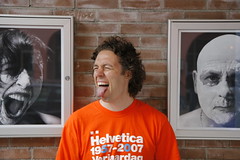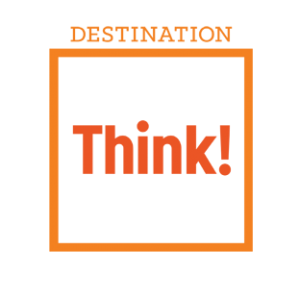August 2007
The Archives
-
Marketing, tourism bc
Analytics driven creative through multi-variance testing
Part of our marketing philosophy is to ask people to do something in our communications, usually with the website as the call to action. It is therefore extremely important to create effective landing pages where people can follow through. A percentage point increase in task completion can make a huge difference in the overall results of a campaign.
A landing page needs to follow through on a call to action, should be relevant to the message, re-enforce it, be credible, desirable and usable. Some of this you can test easily, others not so much within the time and budget available. I’ve stated once in a meeting that I prefer a blank landing page over a aesthetically pleasing landing page if it produced better results. OK, I was a little fictitious but the point is that what matters are results, not personal opinion or preference.
Multi-variance (or A/B) testing is something we have employed for a while now with good results. Try two or more different options to a design, measure the results and roll out the one with the best results. Then use that design as the starting point for further iteration. If you have the traffic, and the right (agile) people and processes, this can be very effective. What you end up with is a design that very much driven by analytics, not personal opinion.
Last spring we used Google’s Website Optimizer to automate the process with great results. Joel, Eric and the rest of the team did a great job and Google wrote up a case study and published it on their website.
-
Travel & Tourism
Canada-e-Connect Conference and Awards
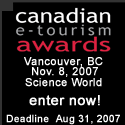
Jens from the Canadian Tourism Commission is organizing the Canada-e-Connect Conference conference in November in Vancouver. I’ve spoken to Jens a few times about it and it looks like there will be great content by interesting speakers. Make sure you read the blog for updates, background info and related content.As part of the conference, the first Canadian e-tourism awards will be presented. If you are in the travel and tourism business, or if you are a traveler with a great story, photo or film, make sure you enter.
If you plan to attend the conference, make sure you drop me a note. I’d love to connect with some of my readers.
-
personal
A week in Amsterdam
08.18.07 | Permalink | 2 CommentsI’m in Amsterdam for a week with my friend Steve. Just a quick break to visit some friends and family and show Steve around. It’s nice to have somebody with you who’s never been here. Makes you appreciate everything more. We’re staying at my Mom’s house at the moment. The first night, Steve suffered through an organized attach by my Mom’s four cats. One after another they decided to wake him up at periodic intervals while one of them tried to stare him down non-stop. It worked, we woke up at 4am (or was it the jet-lag?). We spend they day in Amsterdam were we walked around the city. We watched the sunset on the beach in Noordwijk (how romantic..). The next night Steve got the upper hand on the cats and slept for 15 hours uninterupted (so did I I).
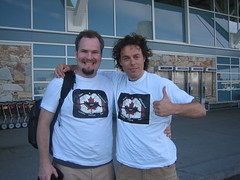
A geek and a photographer at the start of their “Canadian Klootzak Tour”. That can’t be good…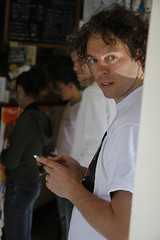
Busted. You can’t get a geek away from his email.
Steve brought a camera from the 60’s for special back & white shots.
Amsterdam’s red light district in two words: sex and drugs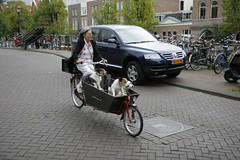
People in Amsterdam are strange, everybody that knows me will probably agree.
We also ran into my buddy Darth.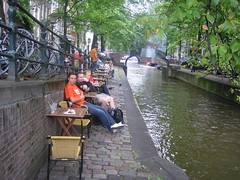
A break from our marathon walk on a patio at a canal, around the corner from the Anne Frank house. We opted not to visit due to the 300 person line-up. -
Links
Week in Links
Marc Andreessen points to an excerpt of Frans Johansson’s book The Medici Effect that explains why brainstorming is a bad idea. Hmmm, I think it depends on the context of the problem that people are brainstorming about, the intellect and skills of people involved, and the size of the group.
Google uses crowdsourcing to create maps In India. Fascinating and incredibly smart.
Lastminute.com promotes carbon offsets. We’re going to see a lot more of this very soon.
Google’s viral campaign to promote Gmail.
-
Internet, Marketing, tourism bc
Results of HelloBC.com’s User Generated Content strategy
08.02.07 | Permalink | 2 CommentsIt’s been a few months since we implemented the first phase of our User Generated Content strategy. I thought this would be a good time to share some results.
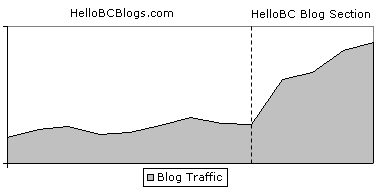
Since we integrated HelloBCBlogs.com into our HelloBC.com website in March, we’ve seen a rapid increase in traffic to our blog entries. In July, we received almost 200,000 blog pageviews. The blog entries help us in our SEO efforts; 5% of our organic Search Engine traffic lands on a blog entry. We also have over 1,000 subscribers to our RSS feed.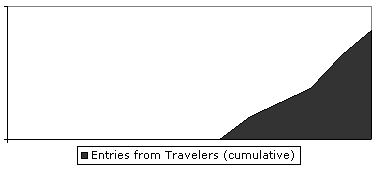
The entries from travelers is showing a steady climb and we’re approaching the 300 mark. We were aiming for quality first; tips and information people can do something with. All entries are tagged with a community and an activity. This allows us to present relevant blog content alongside our official information. Between our staff, visitor centres and traveler entries, we cover almost 100 communities in BC and over 80 activities so far, for a total of 350 community/destination combinations. That makes for a great diversity of content, so it’s working out very well.From a User Experience perspective, the blogs are fantastic. The average pageviews for a blog visitor is 4 times that of an average visitor. Qualitative research conducted in some key markets proved that our unique strategy to position blog entries alongside our official information on the same page is working beautifully. It adds a layer of credibility and insider information consumers really appreciate. Our traffic patterns confirm this as well, many visitors will move back and forth between official information and blogs.
We see room for improvement. We’d like to see more consumer interaction with our blogs for example. People don’t leave many comments, but a fair number of people rate the entries. We have some ideas to further evolve the blogs with the goal to grow it into an online community. I’ll share some more details when I can in the future.
See also my previous post about our User Generated Content strategy.
